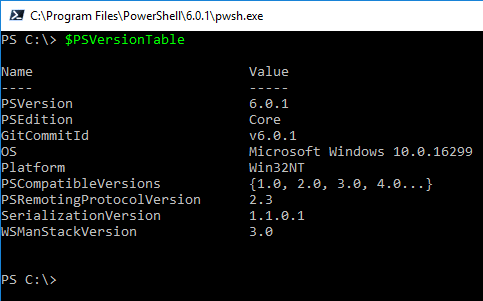Recently, Microsoft has released PowerShell Core as GA. If you have not heard about PowerShell Core, this is the iteration of PowerShell that will be the way forward for the future. PowerShell core provides the long awaited “cross-platform” compatibility. This means you can now install PowerShell Core into not only Windows but also Linux and MAC OS! This is made possible by PowerShell Core’s development on top of the open-source .NET Core platform. This makes possible many new and exciting capabilities from the standpoint of other modules that are integrated with PowerShell Core. Not long on the heels of the announcement of PowerShell Core, VMware has official released VMware PowerCLI 10.0 which is the official release of VMware PowerCLI that runs on top of PowerShell Core. Let’s take a look at VMware PowerCLI 10.0 Release and Installation.
Install PowerShell Core
Starting with VMware PowerCLI 6.5.1, VMware changed the way the PowerCLI installation was carried out. With the 6.5.1 release, the installation truly became a “module” which means you could install it directly from PowerShell itself. As expected, PowerCLI 10.0 can make use of the new PowerShell Core environment and by extension makes it truly cross-platform when used on top of PowerShell Core. By using a few simple commands, we can install PowerCLI 10.0 on top of PowerShell Core. However, PowerCLI 10.0 can be installed on top of the native (legacy) version of PowerShell as well without the benefits such as cross-platform support that PowerShell Core brings. When looking to achieve the new cross-platform support of PowerCLI 10.0, the only requirement is to have PowerShell Core installed.
Quick Look at PowerShell Core Installation
PowerShell Core is supported on the following:
- Windows 7, 8.1, and 10
- Windows Server 2008 R2, 2012 R2, 2016
- Ubuntu 14.04, 16.04, and 17.04
- Debian 8.7+, and 9
- CentOS 7
- Red Hat Enterprise Linux 7
- OpenSUSE 42.2
- Fedora 25, 26
- macOS 10.12+
To install PowerShell Core, pull down the appropriate installation package from the official GitHub link:https://github.com/PowerShell/PowerShell
After installing PowerShell Core, verify the version before beginning the PowerCLI installation:

Verifying PowerShell Core installation via the Version Table
VMware PowerCLI 10.0 Release and Installation
The VMware PowerCLI module is an exciting release since it carries forward the PowerShell Core cross-platform functionality to include VMware PowerCLI, meaning you can now administrate your VMware products via PowerCLI from Linux and Mac! PowerCLI Core also brings support for the following modules:
- VMware.VimAutomation.Cis.Core
- VMware.VimAutomation.Common
- VMware.VimAutomation.Core
- VMware.VimAutomation.Nsxt
- VMware.VimAutomation.Vds
- VMware.VimAutomation.Vmc
- VMware.VimAutomation.Sdk
- VMware.VimAutomation.Storage
- VMware.VimAutomation.StorageUtility
Other Changes to Note:
There are a few other more minor changes to note. First, this version of PowerCLI is now called VMware PowerCLI instead of vSphere PowerCLI. This references the shift from the focus on vSphere centric functionality to include the rest of VMware products.
VMware has also tightened security with this release of PowerCLI in that the default behavior in handling a certificate error is no longer simply a warning but is now a hard error.

PowerCLI 10.0 throws a hard error by default when encountering a certificate error
To continue to bypass certificate errors in PowerCLI 10.0, you need to run the following command:
- Set-PowerCLIConfiguration -InvalidCertificateAction Ignore
Finally, there are several bug fixes and commandlet deprecations in this release of PowerCLI 10.0.
Installation
Below is a quick look at the installation of PowerCLI Core once we have PowerShell Core installed.
Now that PowerShell Core is installed and you have verified the version table, we can pull down the PowerCLI module. Launch a PowerShell Core session. You can run it as administrator after installation by typing pwsh at a Windows 10 search menu and choosing to run as administrator. Or, you can navigate to C:\Program Files\PowerShell\6.0.1 if x64 installation is installed and run pwsh.exe as administrator from there.
Once at the PowerShell Core is installed, we can run the command:
- Install-Module VMware.PowerCLI

Installing VMware.PowerCLI 10.0 in PowerShell Core
You may be asked to accept the untrusted repository. Select either “Y” or “A” to answer Yes or Yes to All.

Trust the Repository for installation
To check the version of PowerCLI installed after PowerCLI 10.0 finishes installing, run the following command:
- Get-Module VMware.PowerCLI -ListAvailable

Checking the version of PowerCLI installed to verify PowerCLI 10.0
Thoughts
VMware PowerCLI 10.0 represents a step forward in many ways for PowerCLI. Building on top of the new PowerShell Core provides the awesome functionality of being able to run PowerCLI code from a Linux or Mac client. This cross-platform functionality is certainly the way forward for not only PowerShell but also PowerCLI. It is definitely an exciting year for automation based on PowerShell Core. It will be very interesting to see all the developments that 2018 brings in the way of additional Powershell Core and PowerCLI enhancements. Be sure to check out both PowerShell Core and PowerCLI if you haven’t already as both are readily available to download for supported platforms.
Experience modern data protection with this latest Vembu BDR Suite v.3.9.0 FREE edition. Try the 30 days free trial here: https://www.bdrsuite.com/vembu-bdr-suite-download/
Follow our Twitter and Facebook feeds for new releases, updates, insightful posts and more



Leave A Comment